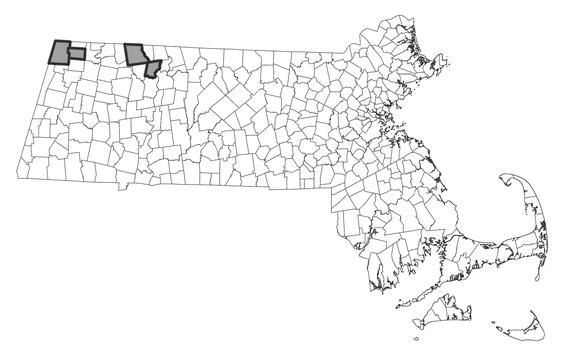- Scientific name: Hydrophyllum canadense L.
- Species of Greatest Conservation Need (MA State Wildlife Action Plan)
- Endangered (MA Endangered Species Act)
Description
Broad waterleaf is an herbaceous perennial in the waterleaf family (Hydrophyllaceae) that grows from long, fleshy rhizomes (horizontal, underground stems). Its slender stem grows 3-5 dm (0.75-1.75 ft) tall. The genus name Hydrophyllum comes from the light green markings on the leaves, which resemble water stains on paper. Broad waterleaf’s alternate, palmately lobed, stem-borne leaves are roundish in general outline, have five to nine lobes, and are unequally toothed. Generally, these leaves are from 1-2 dm (3-9 in) wide; because of their resemblance to maple leaves, the plant is also known as the maple-leaved waterleaf. Broad waterleaf's whitish to pinkish-purple, bell-shaped flowers are pentamerous: there are five united petals, five protruding stamens and a calyx (or outer-most floral whorl) of five parts. Each flower is borne on a very short stalk and is part of a cluster called a cyme.
Virginia waterleaf (Hydrophyllum virginianum) has flowers similar to those of broad waterleaf. Nevertheless, the leaves of Virginia waterleaf are deeply and pinnately divided, while, in contrast, those of broad waterleaf are rather shallowly palmately lobed.
Life cycle and behavior
This is a perennial species. Flowering season is from mid-June through early July.
Population status
Broad waterleaf is listed under the Massachusetts Endangered Species Act as endangered. All listed species are protected from killing, collecting, possessing, or sale and from activities that would destroy habitat and thus directly or indirectly cause mortality or disrupt critical behaviors. Given the relatively large amount of apparently suitable habitat in the Commonwealth, it is puzzling that more colonies have not been found; however, the plant is generally very rare in New England. Broad waterleaf is also considered rare in New Jersey, South Carolina, and Georgia. MassWildlife’s Natural Heritage & Endangered Species Program has 5 records from 2 counties: Berkshire and Franklin. All 5 records have been observed within the last 25 years.
Distribution and abundance
Broad waterleaf’s documented range extends from southern Vermont and western Massachusetts to Maryland, south in the mountains to Georgia and Alabama, and west to Wisconsin, Illinois, Missouri, and northern Arkansas.

Distribution in Massachusetts. 2000-2025. Based on records in the Natural Heritage Database.
Habitat
In general, broad waterleaf is a plant of rich, moist, limy woods. Broad waterleaf's current habitats in Massachusetts include rich, mesic forests, a high-terrace floodplain forest, and steep banks of a mountain brook, under a canopy of sugar maple (Acer saccharum), white ash (Fraxinus americana), and bitternut hickory (Carya cordiformis). Associated understory plants include species of shield-ferns (Dryopteris spp.), bloodroot (Sanguinaria canadensis), wild ginger (Asarum canadense), and blue cohosh (Caulophyllum thalictroides).
Healthy habitats are vital for supporting native wildlife and plants. Explore habitats and learn about conservation and restoration in Massachusetts.
Threats
As a shade adapted species of rich mesic forests, threats to this species in Massachusetts include loss of canopy cover through logging operations (timber harvest), as well as through invasive arthropod attacks on tree species such as emerald ash borer, Dutch elm disease (caused by a beetle), hemlock wooly adelgid, and beech leaf disease (caused by nematodes). Deer herbivory poses an additional threat as deer populations have risen and reduced understory diversity in the eastern U.S. (Blossey & Waller 2024, Miller et al. 2023). Invasive species constitute a significant threat in these forests. In the rich South River State Forest in Conway, MA, DFW botanists have noted large sections of the understory are completely taken over by non-native invasive Japanese barberry (Berberis thunbergii).
Conservation
This plant is short with flowers held underneath the leaves, and typically grows in a lush understory, and sometimes on steep rocky slopes, making discovery of populations a bit more challenging that other species. Given the extensive forest cover in Massachusetts including of this rich mesic type, de novo surveying is likely to produce new finds which are much needed for conservation of this species. There are currently seven populations, with only two sites under strong protection. Site acquisition would be an important conservation tool. More thorough resurvey work on known populations would be helpful. All populations need increased monitoring.
Management needs include removal and control of any invasive species, as well as avoidance of timber harvest in the area. Any means to increase deer hunting pressure would also be beneficial. Monitoring the populations to make sure they are not affected by ATV or off road vehicle use is needed.
This species forms clones which can be measured to determine changes over time, such as expansions or contractions. Research needs include measuring these clones. As a species of moist forests, one research question would seek to learn how drought might affect the populations.
References
Blossey, B., D. Hare, and D. M. Waller. 2024. Where have all the flowers gone? A call for federal leadership in deer management in the United States. Frontiers in Conservation Science 5: 1382132.
Miller, K. M., S. J. Perles, J. P. Schmit, E. R. Matthews, A. S. Weed, J. A. Comiskey, M. R. Marshall, et al. 2023. Overabundant deer and invasive plants drive widespread regeneration debt in eastern United States national parks. Ecological Applications n/a: e2837.
Contact
| Date published: | April 29, 2025 |
|---|